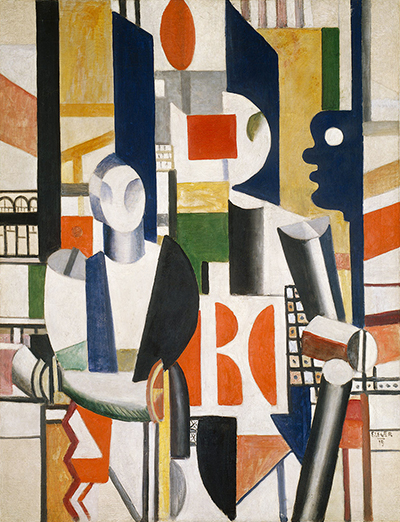Colourful geometric and industrial-looking figures overlap and are conspicuous in this painting including bodies and faces. Léger is exploring these urban themes with his human forms, which are becoming mechanized.
On the left side of the painting, we see a series of curves that maybe some kind of architecture, but then everything has been levelled to these flatforms of overlapping colours and planes. In the urban times of this period, the human form becomes de-individualized and mechanized just as the environment it occupies. Léger was able to illustrate the pulsing ability of contemporary life by finding its artistic match. Shape, colour, and form are primarily considered for their artistic values and are given the same emphasis. They marry one another in a myriad of connections, making single images that capture concurrent sensations.
Confusion of any part of the art is hard because even distribution of planes builds his structure with easily read, blocky areas of flat, unmixed colour and clear incisive outlines. He portrays a deep feeling via overlying planes and varying sizes. Léger’s varied, yet simple and clear graphic elements, like ideal machinery, effectively fabricating effects of sheer power. Léger optimised primary and secondary colours alongside his unique ideology that anyone can reflect and comprehend art. His belief that art could unify people systematically may have led to community-based forms of art and activists’ movements. Feel free to go through our website for more information on this and many other art-related subjects.
Joseph Fernand Henri Léger was a French sculptor, painter, and filmmaker. Alongside varied styles, his work was constantly graphic, favouring patterns, primary colours, and bold. Receptive to the assertive advertising and technological advances that preceded World War I, he began his mechanical phase with works like The City of 1919– 1929, rather similar to Men in the City. Under influence from the chaos of urban lifestyle and his delight in primary colours, he wanted to express the dynamism, speed and noise of new machinery and technology. This often created a feeling of movement in his paintings that caught the epitome of the period just before World War I.
Date of creation: 1919
Art form: Painting
Objects and Subject: Urban Landscape, Portrait
Art Style: Art Nouveau
Technique Used: Oil Painting
Materials Used: Canvas
Size: 145×113 cm
Current Location: The Peggy Guggenheim Collection, Venezia




